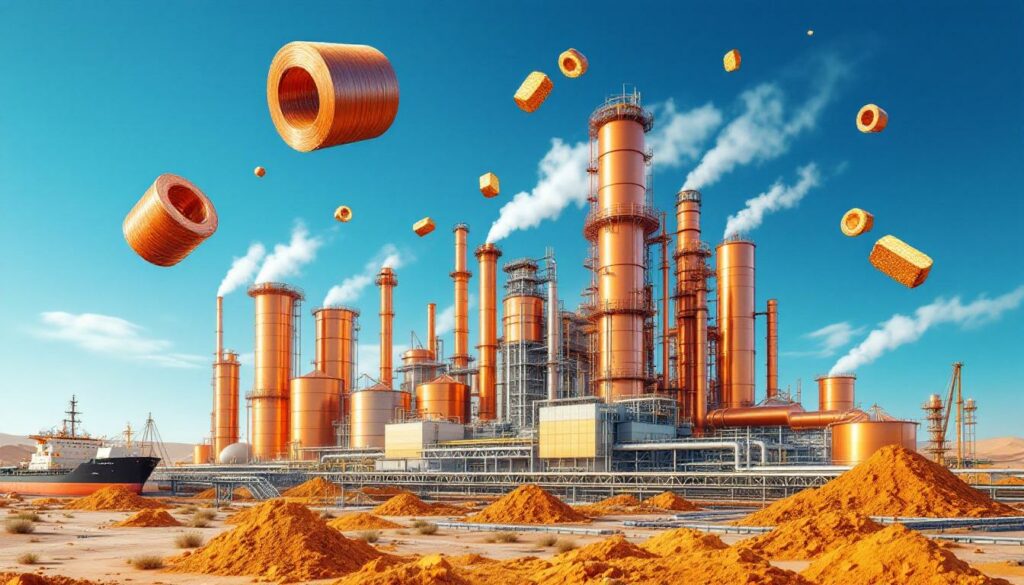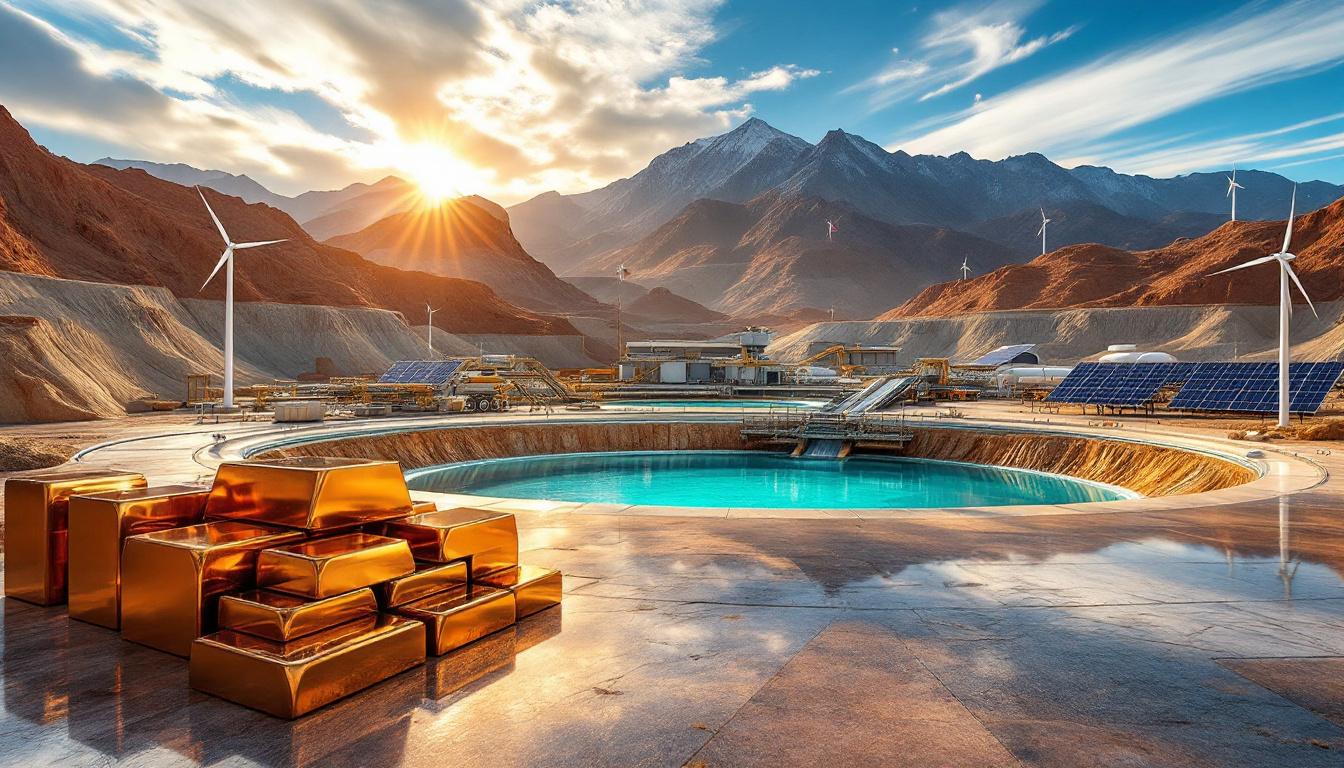What is Adani's Kutch Copper Plant and Why Does it Matter?
Adani's ambitious copper smelting facility in Gujarat represents a major milestone in India's industrial landscape, aiming to reshape the country's position in the global copper supply forecast. The Kutch Copper plant, owned by billionaire Gautam Adani's Adani Enterprises, is strategically positioned to address India's long-standing dependence on imported copper while establishing itself as a significant player in the international copper industry.
The facility features an initial production capacity of 500,000 tonnes per annum (tpa), making it one of India's largest investments in copper processing infrastructure. This capacity represents only the beginning of Adani's vision, as the company plans to double production to a substantial 1 million tonnes by fiscal year 2029 according to the latest industry reports from Mining Technology.
The Strategic Importance of Kutch Copper Plant
India has historically relied heavily on copper imports to meet domestic industrial demand. The Kutch Copper plant's development comes at a particularly critical juncture as copper demand surges and global markets face significant supply challenges.
The plant's strategic importance extends beyond mere production capacity. By establishing this large-scale facility, Adani Enterprises is positioning India to:
- Reduce substantial foreign exchange outflows previously spent on copper imports
- Create a more resilient domestic supply chain for this critical industrial metal
- Support downstream manufacturing sectors that rely on copper as a key input
- Generate significant employment opportunities in Gujarat's industrial corridor
"The move is part of a broader initiative to reduce India's dependence on imported copper," according to Mining Technology's June 2025 analysis, highlighting the plant's significance to India's industrial self-sufficiency goals.
The timing of this facility's launch aligns with increasing global demand for copper, particularly driven by renewable energy technologies, electric vehicles, and electronics manufacturing—all sectors where India aims to expand its manufacturing capabilities.
When Did Adani's Kutch Copper Plant Begin Operations?
After navigating through several challenges and delays, Adani's Kutch Copper plant officially began processing mined ores in June 2025. This milestone represents the culmination of years of planning, construction, and overcoming various market hurdles that pushed back the original timeline.
The project's path to operation has been marked by significant timeline adjustments:
- March 2024: Adani Enterprises launched the first phase of the project
- Original timeline: Operations were initially scheduled to begin in 2024
- June 2025: Plant officially begins processing copper ores, marking a delay of approximately one year
- Current status: Operating but still in ramp-up phase
Timeline of Development and Delays
The facility's development timeline illustrates the complex challenges facing large-scale industrial projects in today's global commodity markets. While most copper smelters typically achieve full operational capacity within 2-3 months of commissioning, Adani's Kutch Copper plant is projected to require up to 18 months to reach its full operational potential.
This extended ramp-up period reflects the current market dynamics, particularly the global shortage of copper concentrates that has affected smelters worldwide. The plant's gradual scaling approach allows Adani to navigate these supply constraints while optimizing operational efficiency.
Industry analysts note that the delay in reaching full capacity isn't unique to Adani's facility but represents a broader trend in the copper smelting industry as competition for raw materials intensifies. The company has adapted its copper investment strategies to account for these market realities while maintaining its long-term expansion goals.
What Challenges Has the Kutch Copper Plant Faced?
The Kutch Copper plant has encountered several significant obstacles that not only delayed its launch but continue to impact its ramp-up timeline and operational strategy. These challenges reflect broader industry dynamics affecting copper producers globally.
Global Copper Concentrate Shortage
The most pressing challenge facing the facility is an acute shortage of copper concentrates—the primary raw material for smelting operations. This shortage has become a worldwide challenge for smelters and stems from multiple factors:
- Rapid global expansion of smelting capacity, creating intense competition for available raw materials
- New integrated plants in mining operations in Indonesia and the Democratic Republic of Congo (DRC) that prioritize processing their own concentrates
- The launch of Tongling Nonferrous Metals' 500,000tpa copper smelter in China, further tightening the market
- Declining processing margins due to increased competition among smelters
Mining Technology reports that the increase in smelting capacity "is partly due to new integrated plants in mining operations […] reducing availability for other smelters." This shortage has forced Adani's facility, like other stand-alone smelters, to compete more aggressively for concentrates on the open market.
Extended Ramp-Up Period
The concentrate shortage has directly contributed to another significant challenge: an unusually extended ramp-up period. According to industry data:
- Typical copper smelters: Reach full capacity within 2-3 months of commissioning
- Adani's Kutch Copper plant: Projected to require up to 18 months to achieve full operational status
This dramatically longer timeline reflects the difficulty in securing sufficient quantities of copper concentrate to feed the smelter at full capacity. The company has had to implement a gradual scaling strategy rather than the rapid ramp-up typically seen in the industry.
"The challenge of securing concentrates has been a global issue for smelters, exacerbated by new plants and declining processing margins," notes Mining Technology's analysis of the situation.
Logistical and Supply Chain Complexities
Beyond raw material shortages, the plant faces additional operational challenges:
- Procurement competition: Stand-alone smelters like Adani's must compete for concentrates against integrated mining companies that prioritize their own smelting operations
- Quality variability: Sourcing from multiple suppliers creates challenges in maintaining consistent processing parameters
- Price volatility: Fluctuating concentrate prices impact operational economics and long-term planning
The facility requires approximately 1.6 million tonnes of concentrated copper ores annually when operating at full capacity, highlighting the scale of the supply chain challenge facing Adani Enterprises.
How Does the Plant Impact India's Copper Industry?
The Kutch Copper plant represents a transformative development for India's domestic copper industry, with far-reaching implications for the country's industrial self-sufficiency and economic positioning.
Reducing Import Dependence
India has historically been heavily dependent on copper imports to meet domestic demand across multiple industries. The new facility aims to address this dependency through:
- Significant domestic capacity addition: Adding 500,000 tonnes initially, with plans to reach 1 million tonnes by 2029
- Import substitution: Reducing the need for costly copper imports that strain foreign exchange reserves
- Supply chain resilience: Creating a more reliable domestic supply for critical industries
The plant's capacity represents a substantial portion of India's total copper consumption, potentially transforming the country from a net importer to a more self-sufficient producer. This shift aligns with broader national objectives to strengthen domestic manufacturing capabilities in critical sectors.
Economic and Industrial Multiplier Effects
Beyond direct production, the Kutch Copper plant generates significant economic benefits:
- Employment creation: Direct jobs at the facility and indirect employment throughout the supply chain
- Industrial ecosystem development: Supporting downstream copper-based manufacturing
- Technology transfer: Introducing advanced smelting technologies and operational expertise
- Export potential: Possibility of export revenue once domestic demands are satisfied
The facility's strategic location in Gujarat, with access to port infrastructure, positions it advantageously for both import of concentrates and potential future export of finished products.
Future Expansion Plans
Adani Enterprises has outlined ambitious growth plans that will further amplify the plant's impact on India's copper industry:
- Current capacity: 500,000 tonnes per annum
- Target capacity: 1 million tonnes by fiscal year 2029, representing a 100% expansion
- Raw material requirements: Scaling to approximately 1.6 million tonnes of concentrated copper ores needed for full-scale operation
This planned expansion underscores Adani's long-term commitment to establishing India as a significant player in the global copper market, despite current raw material challenges.
What's Driving the Global Copper Concentrate Shortage?
The scarcity of copper concentrates represents a fundamental shift in global copper markets that extends well beyond Adani's project, affecting smelters worldwide and reshaping industry dynamics.
Expansion of Global Smelting Capacity
Several factors have contributed to the current shortage, creating an imbalance between concentrate supply and processing capacity:
- New integrated mining-smelting operations: Plants in Indonesia and the Democratic Republic of Congo are prioritizing internal processing rather than selling concentrates to third parties
- Chinese smelting expansion: The launch of Tongling Nonferrous Metals' 500,000tpa copper smelter in China has further increased demand for concentrates
- Global capacity growth outpacing mining: Smelting capacity has expanded more rapidly than mining output, creating a fundamental supply-demand imbalance
- Stand-alone smelter proliferation: The rapid expansion of facilities that procure raw materials from the open market has intensified competition
Mining Technology reports that approximately 40% of new smelting capacity between 2023-2025 came from stand-alone plants, significantly increasing demand pressure on available concentrate supplies.
Shifting Mining Industry Dynamics
Changes in the mining sector have further exacerbated the concentrate shortage:
- Vertical integration strategies: Major mining companies increasingly prefer to process their own output rather than selling concentrates
- Limited new mine development: Exploration and development of new copper mines has not kept pace with smelting capacity growth
- Grade decline in existing mines: Some established mines are experiencing declining ore grades, reducing concentrate output
- Regulatory and environmental constraints: Increased restrictions on mining activities in some regions has limited production growth
These factors combine to create a particularly challenging environment for stand-alone smelters like Adani's Kutch Copper plant that rely on the open market for raw materials.
Impact on Processing Economics
The shortage has created significant economic pressures throughout the copper value chain:
- Declining treatment and refining charges (TC/RCs): These fees, which represent smelter income, have fallen to near five-year lows due to competition for concentrates
- Margin compression: Reduced TC/RCs coupled with high operating costs have squeezed profitability for many smelters
- Negotiating leverage shift: Mining companies now hold stronger positions in contract negotiations with smelters
- Operational adjustments: Many smelters are forced to operate below capacity or extend ramp-up periods
"The industry is experiencing a structural shift in the balance of power between miners and smelters," according to Mining Technology's analysis, highlighting how these dynamics are reshaping traditional industry relationships.
How Does Adani's Copper Plant Compare to Global Competitors?
Adani's facility enters a competitive landscape with several major players expanding their copper smelting operations globally. Understanding this competitive positioning provides important context for evaluating the plant's prospects and challenges.
Key Global Competitors
The copper smelting industry features a diverse mix of players with varying operational models and competitive advantages:
- Tongling Nonferrous Metals: Recently launched a 500,000tpa copper smelter in China, with similar capacity to Adani's initial plant
- Integrated mining operations: Companies like Freeport Indonesia (600,000tpa) and facilities in the DRC that process their own mined materials
- Established Chinese smelters: Companies like Jiangxi Copper (1.8Mtpa) represent benchmark operations with substantial scale advantages
- Stand-alone smelters: Multiple facilities globally competing for concentrates on the open market
This competitive landscape highlights both the scale of competition for raw materials and the benchmark operations against which Adani's facility will be measured.
Competitive Positioning
Adani's Kutch Copper plant has several distinctive elements that shape its competitive position:
- Capacity comparison: The initial 500,000tpa capacity is comparable to other major new smelters, positioning it as a significant but not dominant player
- Expansion ambitions: Plans to double capacity to 1 million tonnes by 2029 would elevate its position in global rankings
- Geographic advantages: Strategic location in Gujarat provides access to shipping infrastructure, potentially reducing logistics costs compared to inland competitors
- Domestic market focus: Unlike export-oriented smelters, Adani benefits from serving India's growing domestic demand
The facility's focus on the Indian market provides some insulation from global competition while still facing the same challenges in securing raw materials.
Technological Comparisons
While specific technical details about Adani's smelting technology aren't fully disclosed, industry standards suggest several likely comparisons:
- Energy efficiency: Newer smelters typically employ more energy-efficient technologies than legacy operations
- Environmental controls: Modern facilities like Adani's likely incorporate advanced emission control systems
- Recovery rates: Contemporary smelters typically achieve copper recovery rates of 95-98%
- Automation level: Newer facilities generally feature higher levels of process automation and digital control
These technological factors significantly impact operational efficiency and environmental performance, though comparative data specific to Adani's facility requires further disclosure.
What Are the Technical Specifications of the Kutch Copper Plant?
The Kutch Copper plant represents a significant industrial undertaking with substantial processing capabilities, requiring sophisticated technology and infrastructure to convert raw materials into refined copper.
Production Capacity and Requirements
The facility's technical specifications highlight the scale of operations:
- Initial capacity: 500,000 tonnes per annum of refined copper
- Planned expansion: 1 million tonnes by fiscal year 2029
- Raw material efficiency: Approximately 3.2 tonnes of concentrate required per tonne of refined copper produced
- Raw material needs: Approximately 1.6 million tonnes of concentrated copper ores required for full-scale operation
This scale places significant demands on supply chain capabilities and operational systems, requiring sophisticated logistics management to ensure consistent raw material supply.
Operational Timeline and Performance Metrics
The plant's operational parameters reflect both industry standards and current market challenges:
- Current status: Processing has begun but at limited capacity due to concentrate availability constraints
- Ramp-up period: Up to 18 months to reach full operational capacity, compared to industry standard of 2-3 months
- Processing technology: Likely employs flash smelting technology (industry standard for modern facilities)
- Energy consumption: Modern smelters typically require 300-400 kWh per tonne of copper produced
The extended ramp-up period represents a significant deviation from industry norms, directly attributable to the global concentrate shortage rather than technical limitations of the facility itself.
Infrastructure and Logistics
The plant's location and supporting infrastructure are critical components of its technical capabilities:
- Port connectivity: Gujarat location provides access to shipping infrastructure for concentrate imports
- Water requirements: Copper smelting requires substantial water resources for processing and cooling
- Power supply: High-capacity electrical connections to support energy-intensive smelting operations
- Waste management: Systems for handling slag and other process byproducts
These infrastructure elements are essential to the plant's operational viability and environmental performance, though specific details on these systems at the Kutch facility would require additional disclosure from Adani Enterprises.
What Does This Development Mean for Copper Markets?
The launch of Adani's facility occurs against a backdrop of significant changes in global copper supply and demand dynamics, with implications extending well beyond India's borders.
Supply Chain Implications
The Kutch Copper plant's entry into the market intensifies several existing trends:
- Further tightening of copper concentrate markets: Adding 500,000tpa of smelting capacity increases competition for already scarce raw materials
- Downward pressure on TC/RCs: Treatment and refining charges may face continued downward pressure as smelters compete for concentrates
- Supplier negotiating power: Mining companies with concentrate to sell gain additional leverage in negotiations
- Potential for vertical integration: More smelters may seek direct investment in mining operations to secure supply
These dynamics reshape the traditional relationships between miners and smelters, potentially driving structural changes in how the industry operates and contracts are negotiated.
Market Outlook
Looking ahead, several key trends will likely shape the copper market's evolution:
- Continued concentrate scarcity: As more smelting capacity comes online globally, competition for raw materials will remain intense
- Strategic partnerships: Increased likelihood of formal partnerships between miners and smelters to secure supply chains
- Price volatility: Potential for increased price volatility in both concentrate and refined copper markets
- Consolidation pressure: Smaller stand-alone smelters may face financial pressure, potentially leading to industry consolidation
For Adani specifically, these market conditions present both challenges in securing sufficient raw materials and opportunities to establish strategic advantages through innovative supply arrangements.
Implications for Copper-Dependent Industries
The development has downstream implications for industries relying on copper:
- Manufacturing input costs: Potential impact on pricing and availability of copper for Indian manufacturers
- Renewable energy sector: Implications for solar, wind, and electric vehicle production that rely heavily on copper
- Construction industry: Effects on building materials supply chains where copper is a key component
- Electronics manufacturing: Potential advantages for India's growing electronics sector through more reliable domestic supply
These interconnections highlight the broader economic significance of the Kutch Copper plant beyond its direct production capacity, particularly as [copper price insights](https://discoveryalert.com.
Want to Stay Ahead of the Next Major Mineral Discovery?
Discover how significant ASX mineral discoveries can generate substantial returns by exploring Discovery Alert's dedicated discoveries page, powered by the proprietary Discovery IQ model. Begin your 30-day free trial today at https://discoveryalert.com.au/discoveries/ and position yourself ahead of the market with instant, actionable insights.




